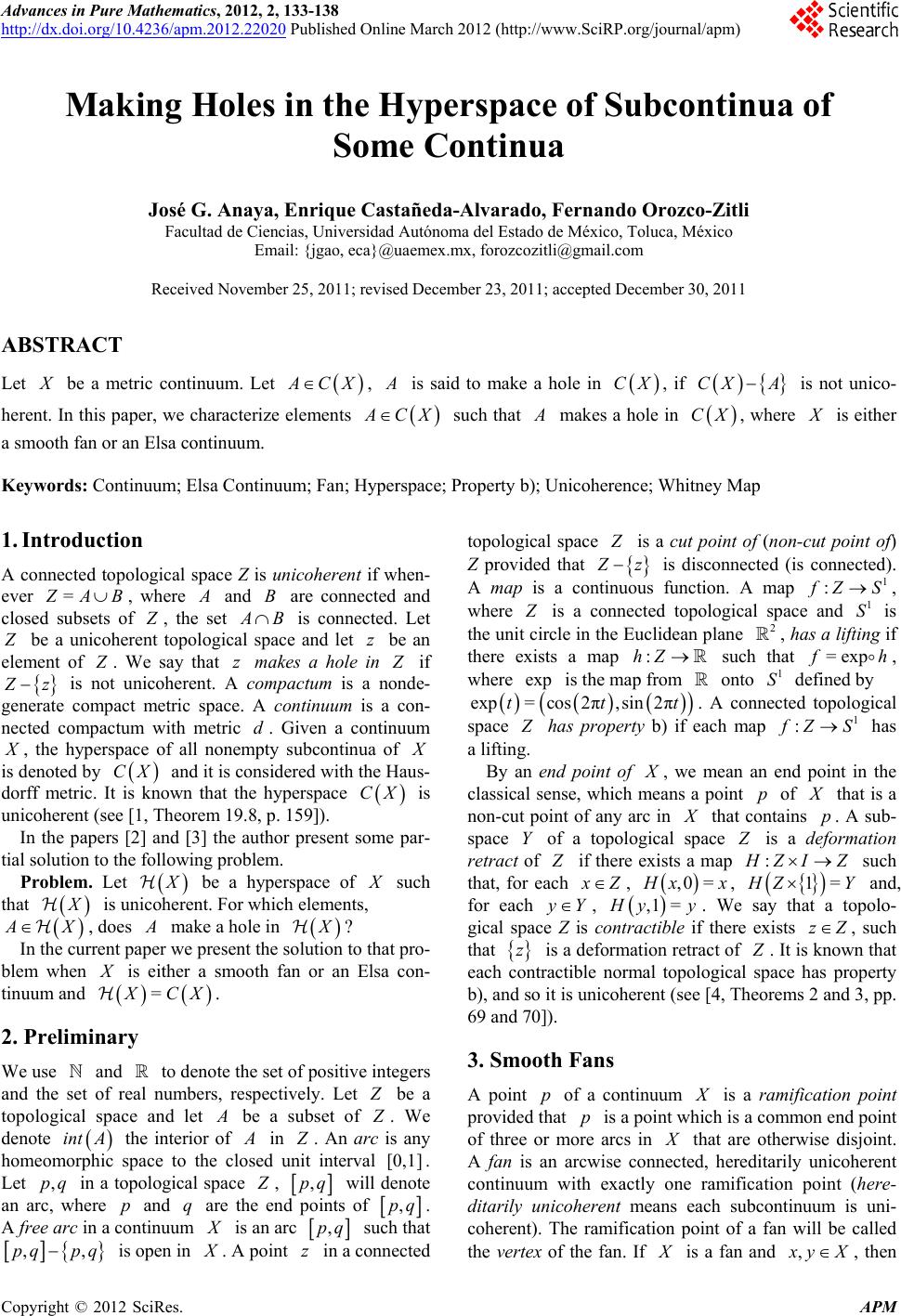 Advances in Pure Mathematics, 2012, 2, 133-138 http://dx.doi.org/10.4236/apm.2012.22020 Published Online March 2012 (http://www.SciRP.org/journal/apm) Making Holes in the Hyperspace of Subcontinua of Some Continua José G. Anaya, Enrique Castañeda-Alvarado, Fernando Orozco-Zitli Facultad de Ciencias, Universidad Autónoma del Estado de México, Toluca, México Email: {jgao, eca}@uaemex.mx, forozcozitli@gmail.com Received November 25, 2011; revised December 23, 2011; accepted December 30, 2011 ABSTRACT CX, Let be a metric continuum. Let is said to make a hole in CX, if is not unico- herent. In this paper, we characterize elements ACX CX such that makes a hole in , where CX is either a smooth fan or an Elsa continuum. Keywords: Continuum; Elsa Continuum; Fan; Hyperspace; Property b); Unicoherence; Whitney Map 1. Introduction A connected topological space Z is unicoherent if when- ever = AB , where and are connected and closed subsets of B , the set B is connected. Let be a unicoherent topological space and let be an element of z . We say that makes a hole in z if z is not unicoherent. A compactum is a nonde- generate compact metric space. A continuum is a con- nected compactum with metric . Given a continuum d , the hyperspace of all nonempty subcontinua of is denoted by and it is considered with the Haus- dorff metric. It is known that the hyperspace CX CX is unicoherent (see [1, Theorem 19.8, p. 159]). In the papers [2] and [3] the author present some par- tial solution to the following problem. Problem. Let be a hyperspace of such that is unicoherent. For which elements, X, does make a hole in ? In the current paper we present the solution to that pro- blem when is either a smooth fan or an Elsa con- tinuum and = CX . 2. Preliminary We use and to denote the set of positive integers and the set of real numbers, respectively. Let be a topological space and let be a subset of . We denote intA the interior of in . An arc is any homeomorphic space to the closed unit interval . Let in a topological space [0,1] ,pq , ,pq will denote an arc, where and are the end points of p q ,pq . A free arc in a continuum is an arc ,pq such that pq p ,q, is open in . A point in a connected topological space is a cut point of (non-cut point of) Z provided that z 1 : is disconnected (is connected). A map is a continuous function. A map ZS, where is a connected topological space and is the unit circle in the Euclidean plane , has a lifting if there exists a map such that 1 S 2 :hZ=exp h exp 1 S , where is the map from onto defined by exp=cos 2π,sin2πttt. A connected topological space 1 : has property b) if each map ZS has a lifting. By an end point of , we mean an end point in the classical sense, which means a point of p that is a non-cut point of any arc in that contains . A sub- space of a topological space p Y is a deformation retract of if there exists a map :ZI Z such that, for each z Z , ,0 =xx , 1= ZY and, for each ,1 = Y , yy zZ . We say that a topolo- gical space Z is contractible if there exists , such that z is a deformation retract of . It is known that each contractible normal topological space has property b), and so it is unicoherent (see [4, Theorems 2 and 3, pp. 69 and 70]). 3. Smooth Fans A point of a continuum p is a ramification point provided that is a point which is a common end point of three or more arcs in p that are otherwise disjoint. A fan is an arcwise connected, hereditarily unicoherent continuum with exactly one ramification point (here- ditarily unicoherent means each subcontinuum is uni- coherent). The ramification point of a fan will be called the vertex of the fan. If is a fan and yX , then , C opyright © 2012 SciRes. APM 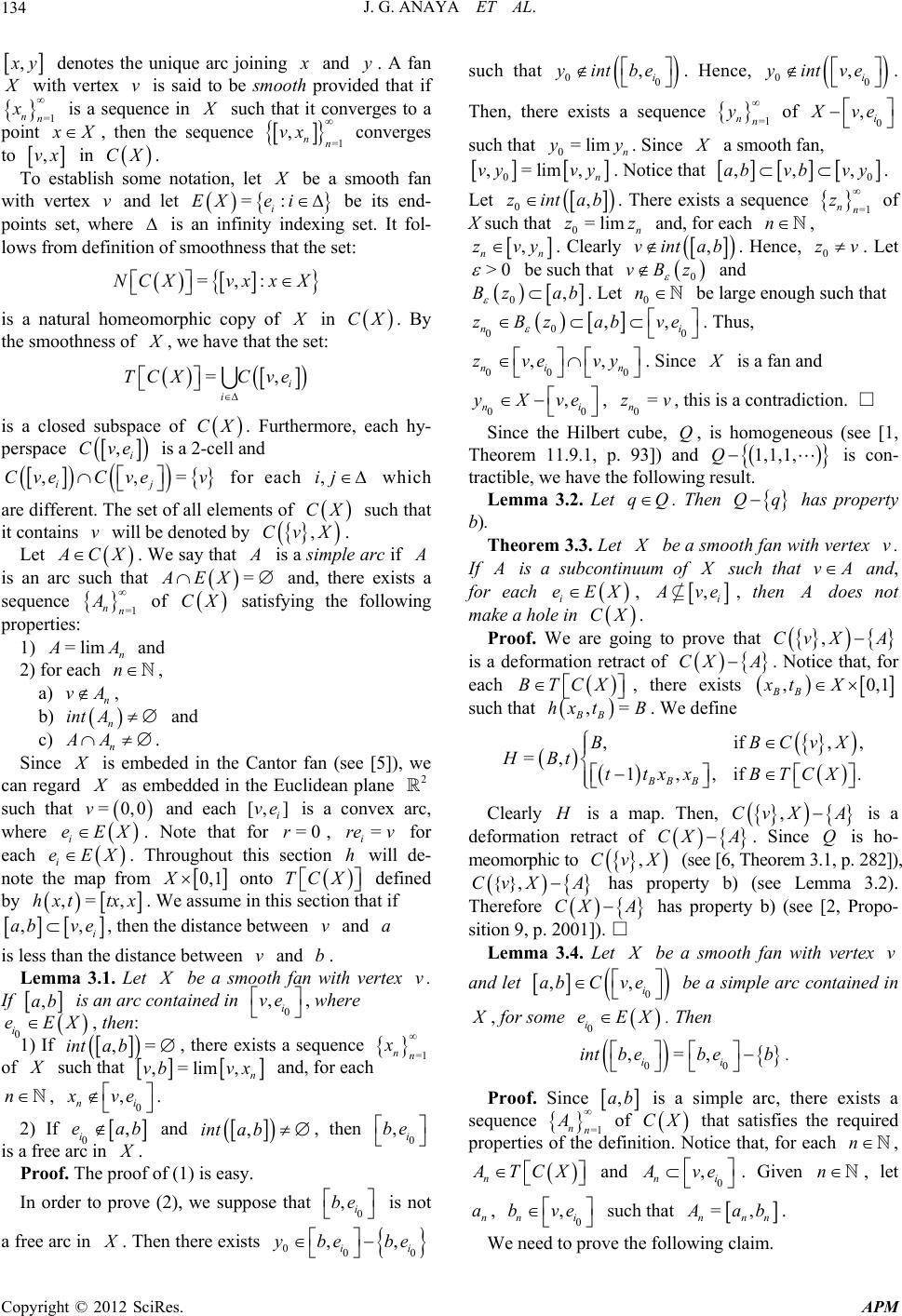 J. G. ANAYA ET AL. 134 Copyright © 2012 SciRes. APM , y denotes the unique arc joining and . A fan y with vertex v is said to be smooth provided that if is a sequence in nn x =1 such that it converges to a point X =1 ,nn vx , then the sequence converges to ,vx in CX. To establish some notation, let be a smooth fan with vertex and let i be its end- points set, where is an infinity indexing set. It fol- lows from definition of smoothness that the set: v EX =:ie x X=,Xv:xNC is a natural homeomorphic copy of in CX. By the smoothness of , we have that the set: =,C v i e i X CX TC is a closed subspace of . Furthermore, each hy- perspace ,Cvi e is a 2-cell and ,=e j v,v i C v Cve for each which ,ij CX ,CvX are different. The set of all elements of such that it contains will be denoted by . Let CX. We say that is a simple arc if is an arc such that and, there exists a sequence of satisfying the following properties: X =AE CX n A im =1n 1) =l n A n n A n A AA and 2) for each , v int a) , b) and c) . n Since is embeded in the Cantor fan (see [5]), we can regard as embedded in the Euclidean plane such that v and each i is a convex arc, where . Note that for , i for each i. Throughout this section will de- note the map from 2 ] i=re v eEXh =0 eE ,0 X [,ve =0r 0,1X onto TC defined by X ,=tx,hx t x. We assume in this section that if ,, i eabv , then the distance between and v a bis less than the distance between and . v Lemma 3.1. Let be a smooth fan with vertex . If v ,ab i eE is an arc contained in , where , then: 0 i X,ve 01) If ,b =1 nn x =int a, there exists a sequence of such that ,=mvb vli , n x and, for each n, 0 , ni ve . 2) If 0 i and ,ae b ,binta, then 0 ,i be is a free arc in . Proof. The proof of (1) is easy. In order to prove (2), we suppose that is not a free arc in 0 ,i be . Then there exists 00 ,, ii e be 0 yb such that 00 ,i yintbe . Hence, 00 ,i yintve =1 nn y 0 ,i . Then, there exists a sequence of ve 0=lim n yy such that . Since a smooth fan, 0 ,=lim, n vy vy . Notice that 0 ,,,ab vbvy . Let ,zintab =1 nn z 0. There exists a sequence of X such that 0 and, for each n, =lim n zz , n zvy n . Clearly ,vintab0 zv. Hence, . Let >0 be such that vBz 0 and 0,Bz ab 0 n. Let 0 00 ,, ni zBz abve be large enough such that 00 0 ,, ni n zve vy . Thus, . Since is a fan and 00 , ni yXve 0= n zv Q 1,1, 1,Q qQ , , this is a contradiction. □ Since the Hilbert cube, , is homogeneous (see [1, Theorem 11.9.1, p. 93]) and is con- tractible, we have the following result. Lemma 3.2. Let . Then has property b). Qq Theorem 3.3. Let be a smooth fan with vertex . If v is a subcontinuum of such that vA and, for each eEX i, ,i ve, then does not make a hole in CX . Proof. We are going to prove that ,CvX A CX A is a deformation retract of . Notice that, for each BTCX , there exists ,0,1 BB xt X such that ,= BB hx tB ,if ,, =, 1,,if . BBB BBCvX HBt ttxx BTCX . We define Clearly is a map. Then, ,X ACv is a deformation retract of CX A. Since Q is ho- meomorphic to ,CvX (see [6, Theorem 3.1, p. 282]), {},CvX A has property b) (see Lemma 3.2). Therefore CX A has property b) (see [2, Propo- sition 9, p. 2001]). □ Lemma 3.4. Let be a smooth fan with vertex v and let 0 ,, i abCve be a simple arc contained in , for some 0 i eEX. Then 00 ,=, ii intb eb eb . Proof. Since ,ab A is a simple arc, there exists a sequence =1 nn of CX n that satisfies the required properties of the definition. Notice that, for each , n TCX 0 , ni and ve . Given n n a0 , ni bve , let , such that =, nnn ab. We need to prove the following claim. 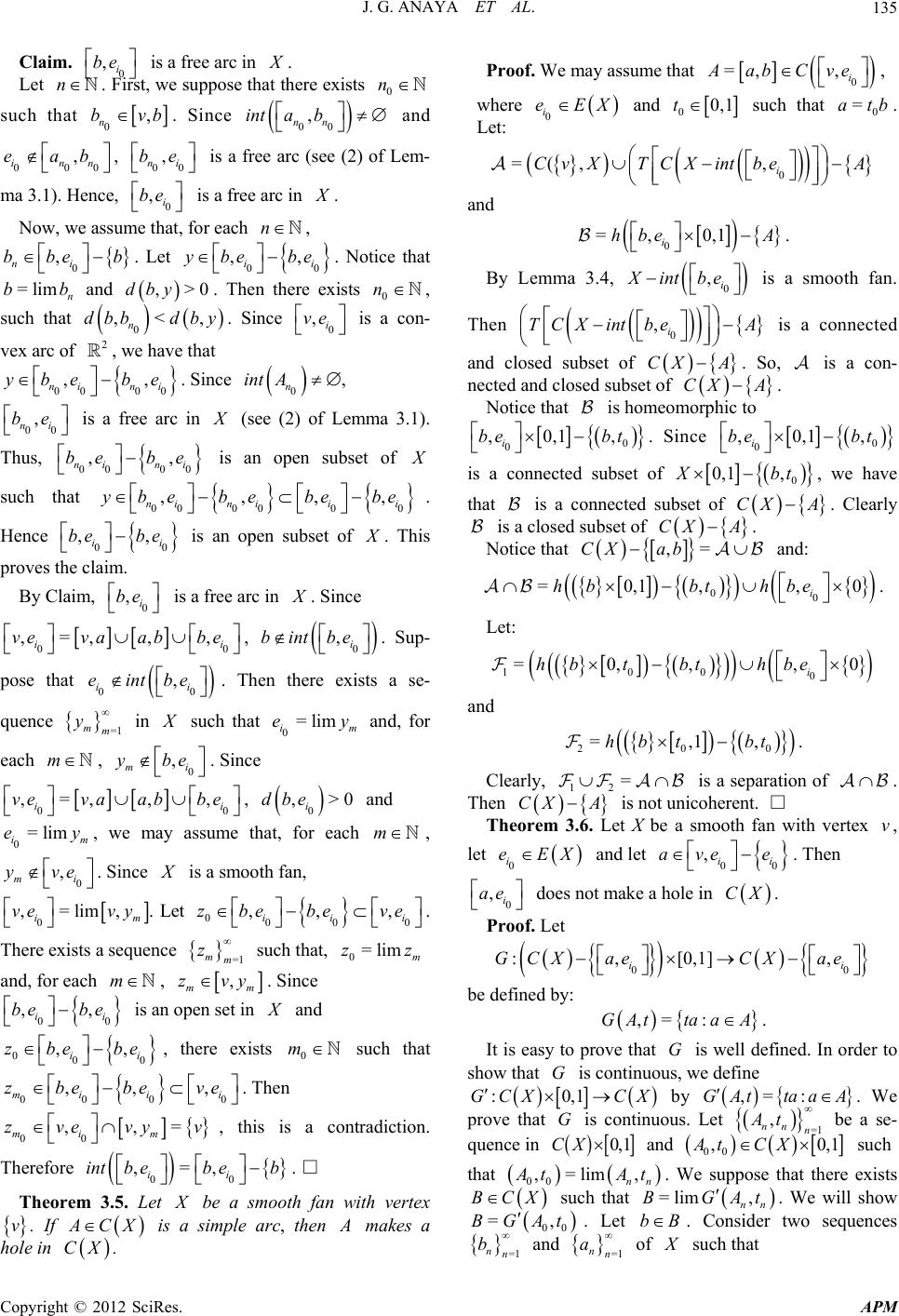 J. G. ANAYA ET AL. 135 Claim. is a free arc in 0 i ,be . Let . First, we suppose that there exists n0 n such that 0 n b 00 , nn b ,vb int a . Since 0 n b 00 , ni be 0 ,i be and 00 , in ea, is a free arc (see (2) of Lem- ma 3.1). Hence, is a free arc in . Now, we assume that, for each , n , ni bb 00 ,, ii e be ,>0y0 n 0 e b yb. Let . Notice that =lim n bb and db. Then there exists 0 ,< n b d0 ,i ve ,e 0, n int A , such that . Since is a con- ,bydb 2 vex arc of , we have that 00 , ni be 00 ni yb 00 , ni be . Since is a free arc in (see (2) of Lemma 3.1). Thus, is an open subset of 00 , ni be 00 , ni be such that 0 0 ,, i i bebe 00 ,, ni beb 00 , i be 00 ni ey , i . Hence is an open subset of be . This proves the claim. By Claim, is a free arc in 0 ,i be . Since ,=, i ve va i =1 mm y i 0 ,i intb e 00 , ,ab be b 00 ,i ntbe , . Sup- pose that ei . Then there exists a se- quence in such that e and, for each , . Since 0=lim im y i ,>0 i dbe 0=lim im ey m m0 , mi ybe ,=, i ve va 00 , ,ab be , and 0 , we may assume that, for each e , . Since 0 , mi yv is a smooth fan, lim, im vy 0,,zbe 0 ve ,= 00 0 , ii i be ve. Let m z0=limm zz . There exists a sequence such that, =1m and, for each , m ,zvy 00 ,, ii be be mm is an open set in . Since and 00 ,, ii e be 0 m 0 i be ,,= m vyv , ii b eb 0 zb zb , there exists such that . Then 00 ,, mi e 0 , i ve 00 mi zve int , this is a contradiction. Therefore . □ ,=be 00 Theorem 3.5. Let be a smooth fan with vertex v. If CX is a simple arc, then makes a hole in . CX 0 =, , i AabCve Proof. We may assume that , where 0 i eEX and 00,1t0 =atb such that . Let: 0 =(,, i CvXTCXintbeA and 0 =, 0,1 i hbeA 0 ,i Xintbe . By Lemma 3.4, is a smooth fan. Then 0 ,i TCX int beA is a connected and closed subset of CX A CX A . So, is a con- nected and closed subset of . Notice that is homeomorphic to 0 0 ,0,1, i be bt . Since 0 0 ,0,1, i be bt is a connected subset of 0 0,1 , bt CX A , we have that is a connected subset of . Clearly is a closed subset of CX A. ,=CX abNotice that and: 00 =0,1, ,0 i hbbt hbe . Let: 100 0 =0,, ,0 i hb tbthbe and 200 =,1,hb tbt 12 = . Clearly, is a separation of . Then CX Av is not unicoherent. □ Theorem 3.6. Let X be a smooth fan with vertex , let 0 i eEX 00 ,ii avee 0 ,i ae and let . Then CX does not make a hole in . Proof. Let 00 :,[0,1], ii GCX aeCX ae be defined by: ,= :GAttaa A G G . It is easy to prove that is well defined. In order to show that is continuous, we define :0,1GCX CX by ,= :GAttaa A G =1 , nn n At . We prove that is continuous. Let be a se- quence in 0,1CX and 00 ,0,1At CX such 00 ,=lim , that nn tAt. We suppose that there exists BCX =lim ,BGAt such that nn. We will show =,BGAt bB 00 . Let . Consider two sequences =1 nn b and =1 nn a of such that Copyright © 2012 SciRes. APM  J. G. ANAYA ET AL. 136 =limb ,bGAt aX nn 00 ,At BG 0 0 ,GA t A=1 nn a :0,1H by n and, for each , nnn , nn and nn . Taking subsequences if nece- ssary, we may assume that there exists 0 such that . Then . Moreover, b = n im n a =ta b n bta 0 aA aA 0=la =limta 0 00 and, so bG . This proves that . Now, let 00 . Then 00 . Then there exists a sequence 00 ,At ta a in such that and, for each , 0nn aA=lim n aa n . So . Since, for each , , . Thus . 00 ta nn ta =l i G mta =,At nn , n A G n tta B n00 00 Hence, is a map. So BG v is a deformation retract of . 0 ,i ae 0 ,i ae 0 e CX Then is contractible. Therefore has property b) (see [2, Proposition 9, CX ,i CX a p. 2001]). □ Theorem 3.7. Let be a smooth fan with vertex , v 0 i eE 0 ,, i C ve let and let such that Xab 0 i,eab and is not a free arc of 0 ,i be . Then ,ab CX does not make a hole in . Proof. In light of Proposition 9 of [2, p. 2001], it suffices to prove that there exist two connected, closed subsets and of ,ab CX which have pro- perty b) and the intersection of them is connected. We may assume that there exists 00,1t 0=tb a 0=0t such that . We consider two cases. Case 1. . Then ,=,vb ab . Let =,Xab TC and ,X ab=,Cv . Clearly has property b). By Theorem 3.1 of [6, p. 282], is a Hilbert cube. By Lemma 3.2, ,CvX has property b). Notice that ,X ab ,=abN C . Clearly ,Xab NC is homeomorphic to b . Since b is connected, ,ab is con- nected. By Proposition 8 of [2], ) ,ab [,]=(CX ab 0>0t has property b). Case 2. . Consider the following sets: 00 1,bt =,hX t and 00 0, ,tbt =,CvX hX . Clearly and are connected, closed subsets of ,abCX and 00 ,t bt=hX . Notice that is homeomorphic to b . So, since b is connected, is connected. have property b). If we define Now, we are going to prove that and ,, =,1 hxt shxtts, we have 1hX 1hX is a deformation retract of . Since is con- tractible, 1hX has property b) (see [2, Proposi- tion 9, p. 2001]). Hence, has property b) (see [2, Proposition 9, p. 2001]). In order to prove that has property b), note that ,CvX is a deformation retract of . By Theorem 3.1 of [6, p. 282], ,CvX is homeomorphic to a Hilbert cube. Thus, ,CvX has property b). Hence, has property b) (see Proposition 9 of [2, p. 2001]). Therefore [,]=CX ab has property b). □ Classification Theorem 3.8. Let be a smooth fan with vertex and v CX. Then makes a hole in CX if and only if a simple arc. Proof. Let CX be such that makes a hole in CX. By Theorem 3 of [2, p. 2001] and by Theorem 3.3, is an arc ,pq . By Theorems 3.6 and 00 ,, , ii pq veve for some 3.7, 0 iX 0 ,i qe eE , and . In order to prove that is a free arc in ,pq =1 nn a n b is a simple arc, let , be sequen- =1n ces in ,,pq pq 0 ,i qe q =limpa =limb and , respectively, such that and q. Then n n ,= , nn pqlima bn and, for each , ,vabnn , ,inta b nn ,, nn pqa b. Therefore and is a simple arc. The sufficiency follows from Theorem 3.5. 4. Elsa Continua A compactification of 0, 0, with an arc as the re- mainder is called an Elsa continuum. The Elsa continua was defined by S. B. Nadler Jr., in [7]. A particular example of an Elsa continuum is the familiar sin(1/x)- continuum. There are uncountably many topologically different Elsa continua, the different topological types being a consequence of different ways “patterns into” the remainder of the compactification [8, p. 184]. Let be a continuum. A Whitney map for CX is a continuous function :[0,1]CX that satisfies the following two conditions: BCX such that , B and 1) for any < B B , , =0x for each X and c) 2) =1X . A Whitney block in CX, respectively a Whitney level in 1, CX, is a set of the form t , res- pectively 1t 01, where t. It is known that Whitney maps always exist (see [1, Theorem 13.4, p. 107]). Moreover, Whitney blocks and Whitney levels in Copyright © 2012 SciRes. APM 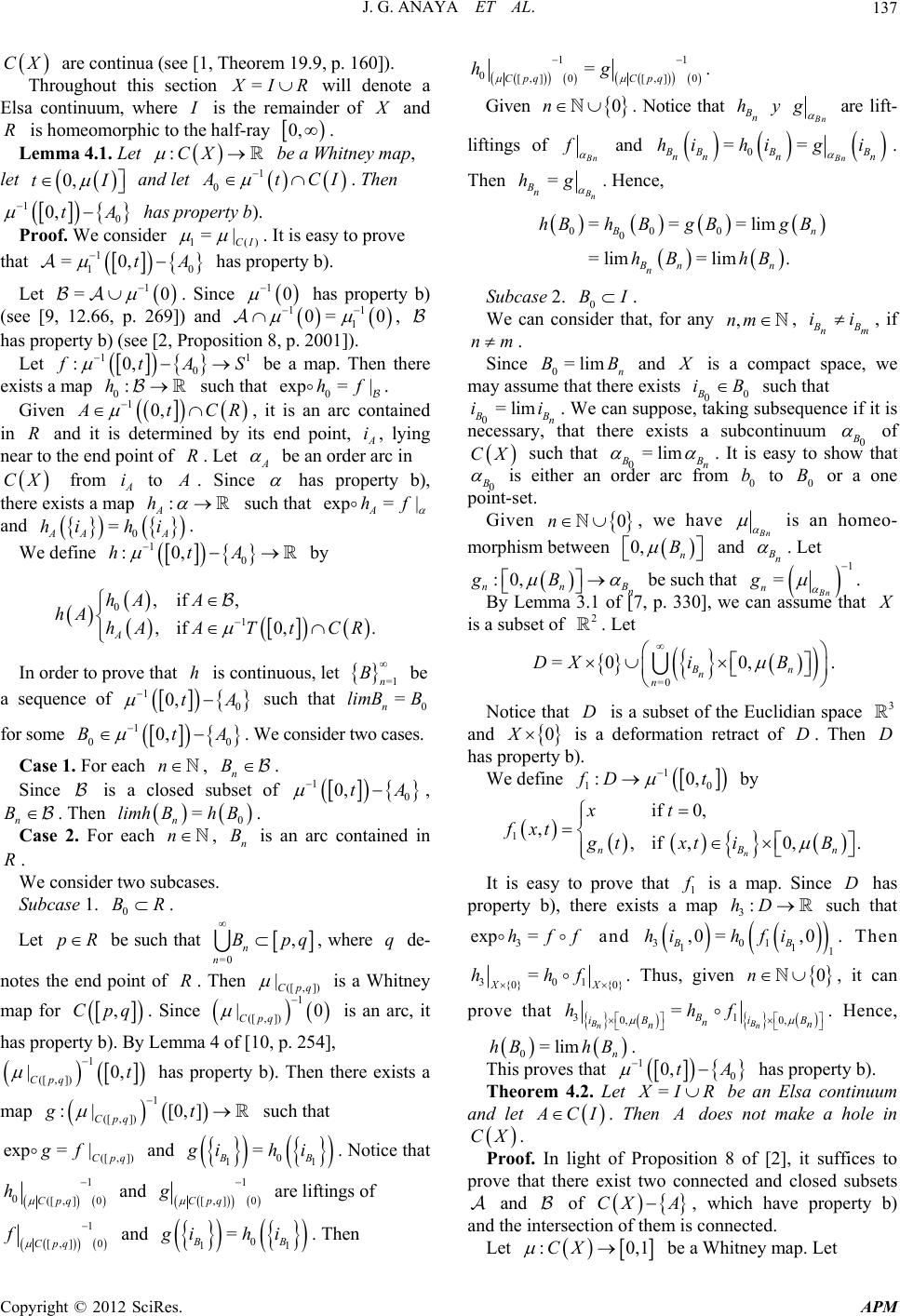 J. G. ANAYA ET AL. 137 CX = are continua (see [1, Theorem 19.9, p. 160]). Throughout this section IR will denote a Elsa continuum, where is the remainder of and is homeomorphic to the half-ray . R 0, 0,t 1 Lemma 4.1. Let be a Whitney map, :CX let and let I 0 tCI . Then 0,tA 1() =| CI 1 0 Proof. We consider has p r operty b). . It is easy to prove that 1 10 =0,tA =0 10 has property b). Let . Since has property b) (see [9, 12.66, p. 269]) and 1 11 10 0=, has property b) (see [2, Proposition 8, p. 2001]). Let :0 11 ,0 tAS exp=|hf 0:h be a map. Then there exists a map such that . 0 Given 10, tCRi R , it is an arc contained in and it is determined by its end point, A, lying near to the end point of . Let R A be an order arc in from A to CX i . Since has property b), there exists a map : A h xp= | A hf s that euch 0 =hi and AA hi A . We define A 1 0 , , .t CR h =1n B :0ht by 0 1 ,if , ,if 0 A hAA hA hAA T In order to prove that is continuous, let be a sequence of 0,t0 = n limB B A 1 0 such that for some 00 0,tA B 1 B . We consider two cases. Case 1. For each , . nn Since is a closed subset of 0 0,tA n B nn R BR p =0 n Bpq q ([,]) |Cpq 1 0 =h B B , . Then . n Blimh Case 2. For each , is an arc contained in . We consider two subcases. Subcase 1. . 0 R n Let be such that , where de- , notes the end point of . Then R is a Whitney map for ,Cpq . Since is an arc, it 1 ([,]) |0 Cpq 1 , ]) |0, qt 1[0,]t = has property b). By Lemma 4 of [10, p. 254], ([Cp has property b). Then there exists a map such that ([ , ]) :| Cpq g ([,]) |Cpq gf exp and 0 11 = BB h igi. Notice that ([ ,Cp 1 ] 0q 0 h and [, ]Cpq g 1 0 are liftings of 1 [,] 0Cpq f and 0 11 = BB h igi. Then 11 0[,] 0 [,]0=Cpq Cpq hg . 0n. Notice that Given n h y n g are lift- liftings of n f and 0 == Bn BB BB nn nn hihigi . Then = n Bn hg . Hence, 000 0 ===lim =lim=lim . n Bn n n hBh BgBgB hB hB BI ,nm Subcase 2. . 0 We can consider that, for any , B nm ii , if nm . Since 0n and =limBB is a compact space, we may assume that there exists 0 0 B such that 0 iB =lim Bn. We can suppose, taking subsequence if it is necessary, that there exists a subcontinuum 0 ii of CX =lim such that 0 Bn . It is easy to show that 0 is either an order arc from b to or a one point-set. 0 0 B 0n, we have Given n is an homeo- 0, n B morphism between and n . Let :0, nn gB B n be such that 1 =g Bn n . By Lemma 3.1 of [7, p. 330], we can assume that is a subset of . Let 2 =0 =0 0, Bn n n DXi B D3 . Notice that is a subset of the Euclidian space and 0XD D is a deformation retract of . Then has property b). 1 10 :0, We define Dt 1 if 0, ,,if ,0,. n nBn xt fxtgtxt iB by It is easy to prove that 1 is a map. Since has property b), there exists a map such that D 3:hD 3 exp =hff 301 11 1 ,0=,0 BB h fihi. Then and 301 {0} {0} = XX hhf 0 . Thus, given n, it can prove that 31 0, 0, =B Bnn BiB iB nn n hhf . Hence, =limn hB hB 0 This proves that . 10,tA = 0 Theorem 4.2. Let has property b). IR be an Elsa continuum and let CI. Then does not make a hole in CX . Proof. In light of Proposition 8 of [2], it suffices to prove that there exist two connected and closed subsets and of CX A, which have property b) and the intersection of them is connected. :0,1CX be a Whitney map. Let Let Copyright © 2012 SciRes. APM 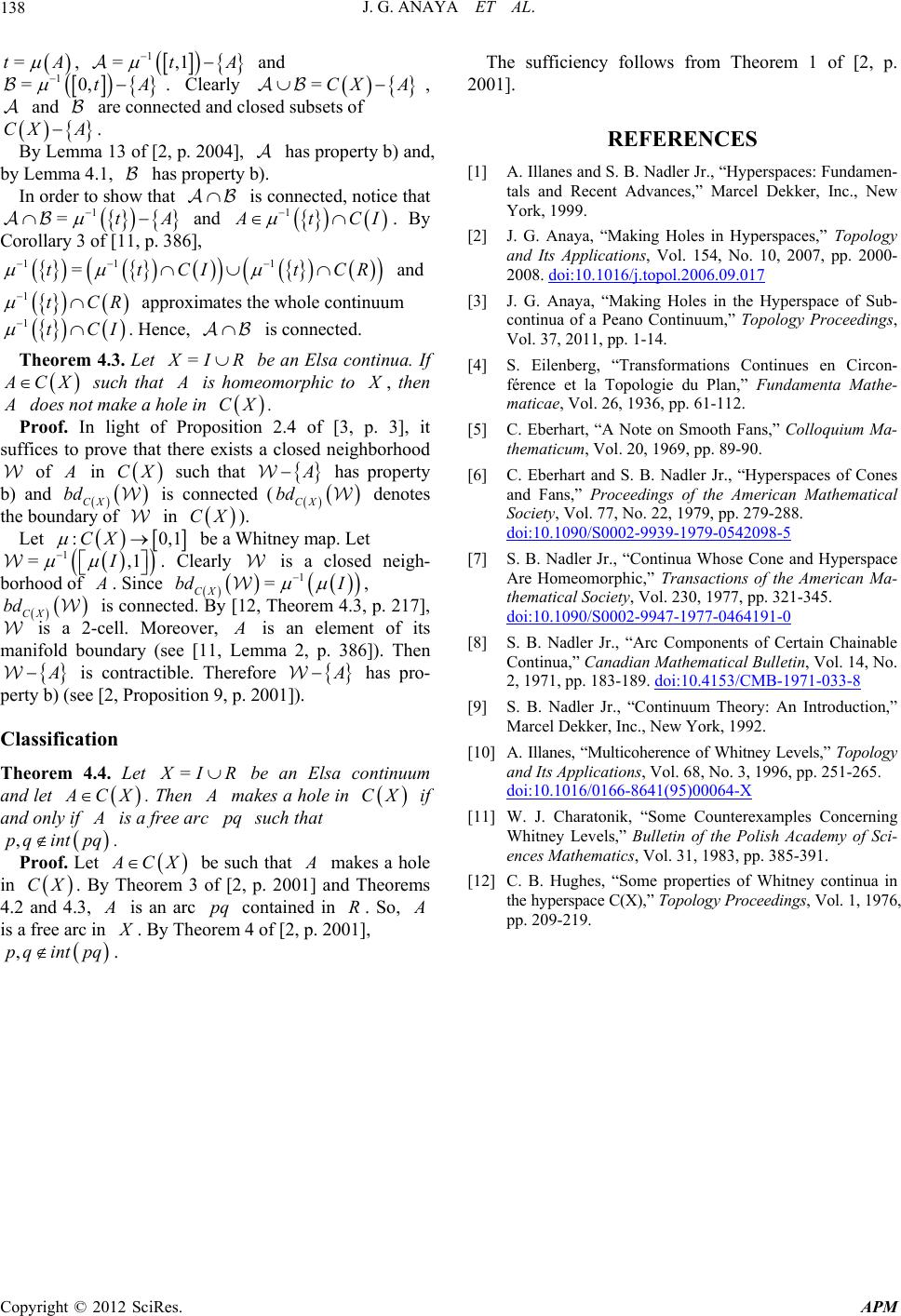 J. G. ANAYA ET AL. Copyright © 2012 SciRes. APM 138 =tA , 1 =,1tA and 1 =0,t A. Clearly CX A A = , and are connected and closed subsets of . CX The sufficiency follows from Theorem 1 of [2, p. 2001]. REFERENCES By Lemma 13 of [2, p. 2004], has property b) and, by Lemma 4.1, has property b). In order to show that is connected, notice that and 1t A= 1 tCI 1 tCR tCR t . By Corollary 3 of [11, p. 386], [1] A. Illanes and S. B. Nadler Jr., “Hyperspaces: Fundamen- tals and Recent Advances,” Marcel Dekker, Inc., New York, 1999. [2] J. G. Anaya, “Making Holes in Hyperspaces,” Topology and Its Applications, Vol. 154, No. 10, 2007, pp. 2000- 2008. doi:10.1016/j.topol.2006.09.017 11 =ttCI 1 and [3] J. G. Anaya, “Making Holes in the Hyperspace of Sub- continua of a Peano Continuum,” Topology Proceedings, Vol. 37, 2011, pp. 1-14. 1 approximates the whole continuum CI. Hence, = is connected. Theorem 4.3. Let IR be an Elsa continua. If [4] S. Eilenberg, “Transformations Continues en Circon- férence et la Topologie du Plan,” Fundamenta Mathe- maticae, Vol. 26, 1936, pp. 61-112. CX such that is homeomorphic to , then does not make a hole in CX. Proof. In light of Proposition 2.4 of [3, p. 3], it suffices to prove that there exists a closed neighborhood of [5] C. Eberhart, “A Note on Smooth Fans,” Colloquium Ma- thematicum, Vol. 20, 1969, pp. 89-90. in such that CX bd CX has property b) and CX is connected (bd denotes the boundary of in ). CX [6] C. Eberhart and S. B. Nadler Jr., “Hyperspaces of Cones and Fans,” Proceedings of the American Mathematical Society, Vol. 77, No. 22, 1979, pp. 279-288. doi:10.1090/S0002-9939-1979-0542098-5 :CX0,1 Let ,1I be a Whitney map. Let 1 = [7] S. B. Nadler Jr., “Continua Whose Cone and Hyperspace Are Homeomorphic,” Transactions of the American Ma- thematical Society, Vol. 230, 1977, pp. 321-345. doi:10.1090/S0002-9947-1977-0464191-0 . Clearly is a closed neigh- borhood of . Since 1 =I CX bd , is connected. By [12, Theorem 4.3, p. 217], is a 2-cell. Moreover, CX bd is an element of its manifold boundary (see [11, Lemma 2, p. 386]). Then is contractible. Therefore [8] S. B. Nadler Jr., “Arc Components of Certain Chainable Continua,” Canadian Mathematical Bulletin, Vol. 14, No. 2, 1971, pp. 183-189. doi:10.4153/CMB-1971-033-8 = has pro- perty b) (see [2, Proposition 9, p. 2001]). [9] S. B. Nadler Jr., “Continuum Theory: An Introduction,” Marcel Dekker, Inc., New York, 1992. Classification [10] A. Illanes, “Multicoherence of Whitney Levels,” Topology and Its Applications, Vol. 68, No. 3, 1996, pp. 251-265. doi:10.1016/0166-8641(95)00064-X Theorem 4.4. Let IR be an Elsa continuum and let CX. Then makes a hole in CX if and only if is a free arc such that . pq int pq,pq [11] W. J. Charatonik, “Some Counterexamples Concerning Whitney Levels,” Bulletin of the Polish Academy of Sci- ences Mathematics, Vol. 31, 1983, pp. 385-391. Proof. Let CX be such that makes a hole in . By Theorem 3 of [2, p. 2001] and Theorems 4.2 and 4.3, CX is an arc contained in R. So, pq [12] C. B. Hughes, “Some properties of Whitney continua in the hyperspace C(X),” Topology Proceedings, Vol. 1, 1976, pp. 209-219. is a free arc in . By Theorem 4 of [2, p. 2001], . q,pqint p
|